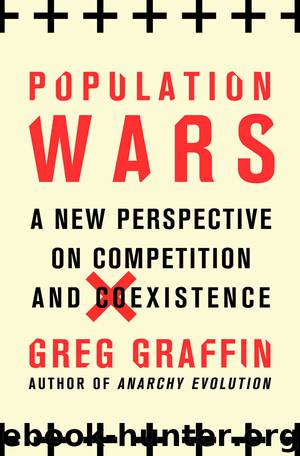Population Wars: A New Perspective on Competition and Coexistence by Greg Graffin

Author:Greg Graffin [Graffin, Greg]
Language: eng
Format: epub
Tags: History, World, Politics & Social Sciences, Social Sciences, Violence in Society, Science & Math
ISBN: 9781250017611
Amazon: B00UG65LOS
Publisher: Thomas Dunne Books
Published: 2015-09-14T22:00:00+00:00
7
WAR IS UNWINNABLE
America’s most infamous war is the one we call “Civil.” After its brutal conclusion, Gen. William Tecumseh Sherman told the citizens of the united Republic, in a speech to school kids, that war is all hell. The chronology of American history is usually depicted as a sequence of these hellacious episodes. Just as the history of the biosphere is revealed by the fossil record—communities of intermingling species interrupted by periodic mass extinctions—we trace our cultural inheritance by narratives of combat that interrupt periods of “peace.”
In this chapter I intend to show that this history of human warfare has some of the same characteristics as the “warfare” between species that we see in nature. That is to say, war is an inevitable feature of all populations. If we view wars as the culmination of incompatible uses or acquisition of resources, it’s easy to understand their inevitability in the course of human events. Just as populations in an ecosystem are thrust together in competition for limited resources (food, nesting sites, home ranges, and so on), human populations eventually intrude on each other as their numbers increase. Nations experience destabilization when this happens to their people, often resulting in destabilization of populations that were once in equilibrium.
None of us were actually present during these conflicts of old, yet we still align ourselves with one side or another. We know who the “good guys” were, at least according to our own historical circumstances. We can make a list of the “bad guys’” deplorable traits.
Conventional warfare tends to mimic some trends seen in wild populations. For instance, many human conflicts can be reduced to wars over resource utilization (think of oil in the Middle East). But human wars differ from population wars in nature because they are predicated as much on ideology as on natural resources (even though wars over oil have raged for decades, the political justification for entering the conflicts has centered on democracy, communism, or some religious doctrine). Ideas can spread like an infectious disease. Although this may sound like a poetic lyric, in fact thoughts are transmitted in culture just as biological traits are passed from one generation to the next. These phenomena simply use different mechanisms of replication and transmission. In the case of organismic traits, genes are the units of replication, and they are passed from parent to offspring. In the case of ideas or ideologies, symbols (words, gestures, rituals, and the like) are the mechanism of replication, and they can be passed from parent to offspring or from any two members of the same culture. Even though it can spread out of control, ideology is manageable to some degree, and therefore we have the potential to alleviate much human suffering.
Ideas spread quickly in our modern industrialized society: new ways of advertising, new products, and new behaviors, some useful, and some not. Our culture—like most populations’—is constantly changing. I like to believe that I can choose to ignore these changes and remain unaffected by them, but if
Download
This site does not store any files on its server. We only index and link to content provided by other sites. Please contact the content providers to delete copyright contents if any and email us, we'll remove relevant links or contents immediately.
Cecilia; Or, Memoirs of an Heiress — Volume 1 by Fanny Burney(32411)
Cecilia; Or, Memoirs of an Heiress — Volume 3 by Fanny Burney(31818)
Cecilia; Or, Memoirs of an Heiress — Volume 2 by Fanny Burney(31795)
The Great Music City by Andrea Baker(31248)
We're Going to Need More Wine by Gabrielle Union(18950)
All the Missing Girls by Megan Miranda(15487)
Pimp by Iceberg Slim(14312)
Bombshells: Glamour Girls of a Lifetime by Sullivan Steve(13949)
Talking to Strangers by Malcolm Gladwell(13183)
Norse Mythology by Gaiman Neil(13167)
Fifty Shades Freed by E L James(13144)
For the Love of Europe by Rick Steves(12613)
Mindhunter: Inside the FBI's Elite Serial Crime Unit by John E. Douglas & Mark Olshaker(9158)
Crazy Rich Asians by Kevin Kwan(9146)
The Lost Art of Listening by Michael P. Nichols(7385)
Enlightenment Now: The Case for Reason, Science, Humanism, and Progress by Steven Pinker(7158)
The Four Agreements by Don Miguel Ruiz(6595)
Bad Blood by John Carreyrou(6517)
Weapons of Math Destruction by Cathy O'Neil(6116)
